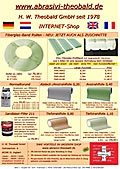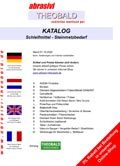Print
Home About brushes For users
For users
User Information on our brushes
- Basically, all brushes must be used with the use of water. This is used for cooling and removal of abrasion or dust prevention. A dry-use on a single machine only briefly is possible, whereby the consumption significantly increased and the dust can / be disruptive to health.
- Please note that round brushes may be driven at a maximum speed of no more than 2,000 rpm. At higher speeds the bristles bend outwards - and remain in this position!
Such a misapplication results in complete loss of function with round brushes - it can no longer be used correctly!
- SIC is the abbreviation for silicon carbide (eng. Silicon carbide), and is known in Germany under the brand name carborundum. An earlier demanded surface refinement with "sanding C 220" includes the C point to a result that only with the use of this abrasive grain Carborundum was 220 achieved.
- DIA-brush is, the abrasive ingredient in the nylon bristles, which previously consisted of carborundum grit, is now replaced by a diamond grit. The abrasion is now much larger in a shorter time, no matter how hard the rock or its mineral composition.
Different naming and effect:
- SIC is available in grain 16-24-36-46-60-80-120-180-240-320-500-1000 and and refers to a sieve line.
- DIA has different gradations, referring to the American Mesh system. There are grades 30-40 / 40-50 / 60-80 ... 170-200 / 320-400 and others.
- Only the particle size says nothing about the mode of action, which is why we need to change our understanding completely. The result of a DIA 200 is similar to that of an SIC 120, a DIA 400 similar to an SIC 220; DIA 800 is roughly comparable to SIC 400 and DIA 3500 is approximately equivalent to SIC 1200. A polishing result can be reached at DIA 6000-10000 (this is for example included in the Buff / Polisher). DIA can not simply be inserted into the sequence of SIC grits with the same particle-nominal designation.
- Start, for example, with DIA Brush 36/60/120 for fast and effective glazing. If you want to achieve a higher degree of gloss, change to SIC, as has a 120 SIC-brush can be used as the next brush again and then the following grits with SIC 180-240-320-500.
- If your SIC brush 320 is worn out and you now want to try a DIA brush as a substitute, then take a DIA 600 in order to have an appropriate result. If you want to change your SIC 500 to a substitute of diamond, you need at least a DIA 1000 or DIA 1200. For a better understanding it is necessary to get more experience, especially since the match of this simplified "doubling" is not always true 100%.
- Structure is the visually recognizable, different flat surface of various stone surfaces with their different hard mineral constituents or their different texture such as streaks, clouds and veining that each material are uniquely its own.
- Materials with uniformly arranged minerals such as Nero Assoluto, Impala and all fine-grained Engineered Stone products as well as all mono-mineral rocks have an appearance with little high-low effect. This is also independent of a longer exposure time or by the use of coarser grains DIA. In Engineered Stone products, the achievable vertical drop to about half of the grain diameter of the material is limited. Only half of the "glue" can be brushed. The surface thus obtained is usually referred to as a "Leather Touch".
- Materials with strong texture or structure (such as cloudy effect and veins), where in addition there is a mineral hardness difference between the textures and the surrounding minerals, also show after brushing always this individual texture. The higher the hardness difference between the adjacent mineral stocks, the higher falls from the high-low effect. The thus obtained surface - starting from a smooth, flat surface - is called "satin" finish.







